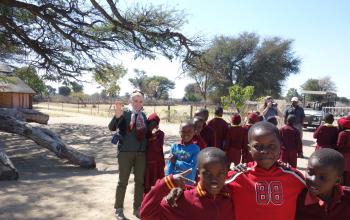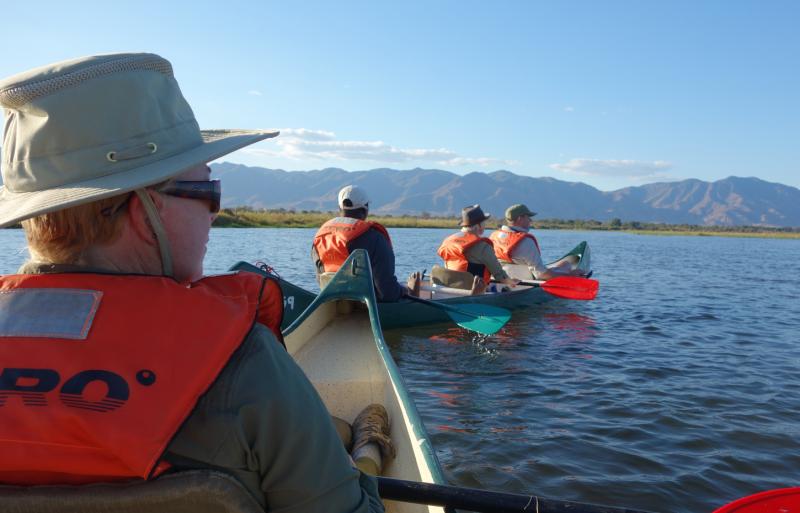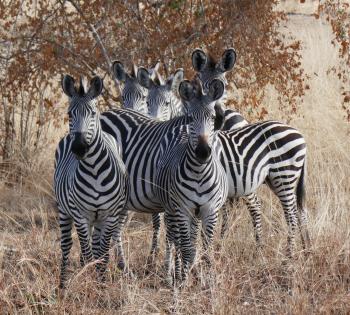Walking among the wildlife in Zambia and Zimbabwe
This article appears on page 34 of the November 2016 issue.
Kennedy whispered, “Watch where you step. Try to avoid twigs, and move slowly toward the tree ahead.”
We watched the ground carefully, avoiding any brush or twigs that might alert the elephant herd ahead. We approached the tree single file, standing directly behind our guide. Then, moving behind us, silently he put his hands on my shoulders and positioned me just left of the tree but still somewhat covered by it. Similarly, he placed my husband, Rick, on the other side.
The elephants didn’t seem to know we were only about 100 meters away!
This was the first of many highlights on our July 2016 walking safaris in Zambia and Zimbabwe.
Making plans
We had taken jeep safaris at Sabi Sand Game Reserve in South Africa and at the Shinde and Tubu Tree camps in the Okavango Delta in Botswana four years earlier. After reading about walking safaris in International Travel News, we knew that this would be a different experience.
We had worked very successfully with Rothschild Safaris (Denver, CO; 800/405-9463, rothschildsafaris.
com) for our last trip, so, without hesitation, we contacted them again to arrange this new adventure. Leora Rothschild and her staff were very knowledgeable about the walking safari experience and agreed that the countries to go to were Zambia and Zimbabwe. Knowing about our travel preferences from the earlier trip we had taken with them helped make this planning process very efficient.
Our tour would begin in Lusaka, Zambia, and end in Harare, Zimbabwe. The price for the two of us, including four nights at each of the four camps on our itinerary plus key transfers, was $26,886 plus $2,570 for the flights from camp to camp.
Getting there
We used frequent-flyer miles to get us from San Jose, California, to London and on to Johannesburg. We then flew South African Airways from Joburg to Lusaka and, on our return journey, from Harare to Joburg for $420 each. We again used frequent-flyer miles to get from Joburg to Prague, then we flew (and enjoyed) Norwegian’s LowFare option from Prague back to Oakland, in the San Francisco Bay Area, for $659 each.
We stayed in London for a week prior to starting the safari in order to adjust to the time difference, as London’s and Zambia’s time zones are only one hour apart. On the way home, we also spent a week in Prague.
We were met by Rothschild associates at our two key international transit points — upon our arrival in Lusaka, with hotel transfers there, and for the drive from Livingstone, Zambia, to Victoria Falls, on the border with Zimbabwe. Their assistance was much appreciated, as we saw that without a knowledgeable guide during these transfers we would have had a much more difficult time with the logistics.
Game drives & walking safaris
We spent our first night at the Protea Hotel by Marriott in Lusaka on our way to our first camp, Flatdogs, located in the South Luangwa National Park in Zambia’s Eastern Province.
The game viewing at Flatdogs was superb. There were more animals and a greater variety of animals in South Luangwa than in any of the other parks we visited. There were tons of hippos, both in the river and on land around the camp.
On just our first ride out, we saw a lion family of three; a leopard; slews of antelopes, of course; zebras; wonderful warthogs; a cobra slithering up a tree, and a very large herd of Cape buffalo that blocked the road for almost 10 minutes as they crossed in front of us, causing a jungle traffic jam.
An important element of our rides was the foresight of Kennedy, our guide for our entire stay. He spotted where animals were and headed over toward where he (correctly) figured they were heading. That skill enabled us to, for example, see several beautiful painted wild dogs, which then coalesced into a pack that brought down an impala. We saw them feed on it as they each took a turn getting meat and then moved aside for the next one before the vultures settled in.
Our game viewing continued wonderfully, including sitting and watching a pride of lions, one female with large and powerful paws seeming to evaluate us as a potential meal before settling back to play with her cubs instead.
We also took our first two walking safaris at this camp, learning the rules and procedure and getting somewhat close to several groups of hippos, in particular. Flatdogs provided the highest level of walking safety, with an armed guard, a guide and an additional guide at the rear of our group.
The camp staff was the warmest and most gracious we encountered at our four camps. Everyone was very focused on helping to make our stay as comfortable and smooth as possible.
Change of plans
Next, we were initially scheduled to stay at Kasaka River Lodge in Zambia’s Lower Zambezi National Park, but as we were settling in at Flatdogs, the manager advised us that a corporation had booked most of the accommodations at Kasaka for an off-site business meeting.
Kasaka still had our tent available, but they offered us the option of an upgrade, at no additional cost, to one of their sister camps, Chongwe River Camp, also located in the Lower Zambezi, to avoid our being caught in the middle of business meetings and PowerPoint presentations at dinner. We agreed to the upgrade.
As we were heading to the Lower Zambezi from South Luangwa, we were advised to be prepared to see less game, and that proved to be very accurate.
Of our two walking safaris at Chongwe, the second was far better, as we were able to see and be in range of several groups of elephants. This second walk took place on an island that was about seven minutes by motorboat from the camp, and apparently some special arrangements had needed to be made. It was the highlight of our stay at Chongwe.
Walking safaris there were accompanied by one armed guard and one guide. Moses, a knowledgeable and experienced guide, worked hard for us, but he could only work with what was there. One morning he even left camp early and jeeped upriver to a location where lions had been reported, and we met him there after a 20-minute boat ride.
Chongwe is a bit more upscale than some of the other area camps, and that was reflected, for example, in several lovely riverside lunches we enjoyed there.
On to Zimbabwe
While we could see Zimbabwe just across the Zambezi River from our camp, maybe a 20-minute boat ride away, it was necessary for us to accomplish our border crossing by flying into Lusaka and then Livingstone, followed by a 40-minute drive to the Victoria Falls airport for our flight to our camp. In all, it actually took almost eight hours to move from Chongwe to Davison’s Camp in Zimbabwe’s Hwange National Park.
With two notable exceptions, Davison’s was the disappointment out of our four camps. The first exception was its watering hole. Davison’s has a well that feeds a large watering hole, just behind the camp’s main building, where large herds of elephants gather to drink each day. Sitting and watching from the deck put us in close proximity to those herds.
Davison’s also has wells that provide water at several places out on the plain, in places where the animals would otherwise not have water. This is a great service and sometimes also provides viewing opportunities.
The other positive exception was a village visit. Our best activity at Davison’s, the visit included an hour-plus discussion with the headman of the nearby village and his wife. The headman leads a village of 170 families, and he is part of a system of headmen (and women), sub-chiefs and chiefs who have authority over day-to-day living for many in Zimbabwe.
He shared his broad knowledge about his community and country, and he was informed about events around the world. This opportunity to learn about the tribal part of the governance system of the country was very special and much appreciated.
But, overall, the game at Hwange was somewhat scarce. It felt like there were only two cheetahs, one leopard and one small lion family in the entire park.
We also found the walking safari guide who was available to us (the camp has two guides) to be unprofessional and hostile, and we passed on a second walk with him.
Also, in July, the middle of winter there, the morning temperatures were much lower than those at any other camp we visited. On our four mornings, readings were 41, 39, 24 and 32 degrees Fahrenheit, respectively. Layering up as we did at all the other camps was not sufficient. A ski parka layer would have also been necessary to be comfortable.
Impressed with Ruckomechi
Our last stop in Africa was Ruckomechi Camp in Mana Pools National Park, Zimbabwe.
As noted, our primary reason for choosing the four camps in Zambia and Zimbabwe was to be able to take walking safaris, and at Ruckomechi we were fortunate to have a truly superior guide assigned to us.
Kamba, who had worked previously as a tracker, really made the difference in so many ways. He brought his tracking skills to bear in both our walking and jeep safaris.
In the jeep, he spotted a family of lions heading into the bush one evening, and the next day he was able to track them so we could spend time with this family of two lionesses and five adorable cubs, who sat and looked at us as we looked at them.
We did three walks in three days at Ruckomechi, and, with the leadership of Kamba, they were exceptional.
In particular, we were able to get close to two different families of elephants. Kamba tracked them, and he walked us in upwind of the animals so that they weren’t able to use their good sense of smell to detect us. (Their relatively weak eyesight was another factor on our side.)
As one family of elephants walked off into the bush, Kamba spotted a hyena in the grass, and we were able to move toward it as well.
On our way out to a walk one morning, Kamba tracked the lions that had been heard but not seen in the camp the evening before, and we got to see them.
Our camp was also frequented by many elephants. We had some just off the porch of our tent, and one elephant came right up to and almost onto the deck one afternoon while tea was being served!
Some observations
Particularly for walking safaris, travelers should dress properly. Tans and light greens are good. Leave your bright-colored clothes at home.
On one walk, a man who joined our group that day was wearing a bright blue-and-red plaid shirt, which meant we needed to stay somewhat farther back from the animals because of his high visibility.
We really enjoyed our interactions with Kamba during our safaris. Being able to appreciate each other’s senses of humor across our cultural divides was an extra delight. The management staff at Ruckomechi, Michelle and Amy, were also very present and helpful.
While the July winter mornings were quite cold at Mana Pools, it was more tolerable than our experience in Hwange. We would guess that the weather also can be hot and humid at Mana Pools during some months.
All in all, we were delighted with our journey in Africa. Seeing beautiful wild animals in the bush was spectacular, and, at least for us, being on the ground was special.



